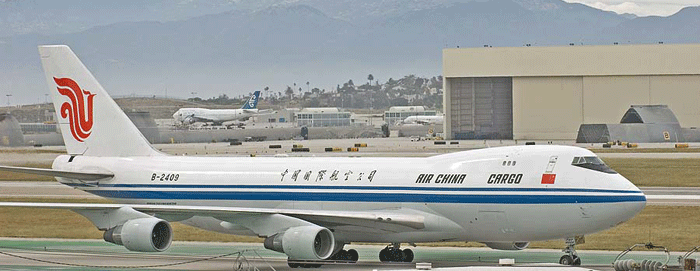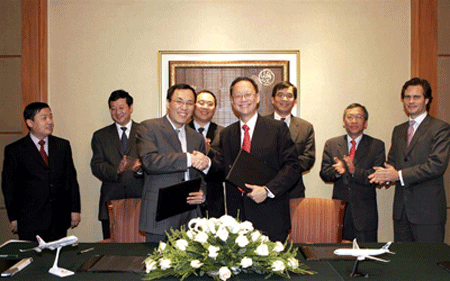Development
Trends Of China's
Air Cargo Business

(Shanghai Exclusive—Interview with Mr. Li Jiaxiang, Chairman
of Air China Limited)
 In
this golden autumn, during an interview at Air China Limited headquarters
in Beijing, Mr. Li said that separating passenger and cargo businesses
is the main trend of China’s air cargo business. In
this golden autumn, during an interview at Air China Limited headquarters
in Beijing, Mr. Li said that separating passenger and cargo businesses
is the main trend of China’s air cargo business.
“Besides the foreign airlines, such
as Lufthansa, Air France and Japan Airlines, several domestic airlines
also have finished breaking up their passenger and cargo business into
separate units.”
Statistic data provided by Sinotrans Air,
a listed company in Shanghai Stock Exchange, indicate that China’s
air cargo business is experiencing a phenomenal pace of development.
After China entered WTO, the volume of air
cargo has consistently maintained a double-digit growth rate.
“But what is more important is the
establishment of the “Cargo First” principle, which directs
steps to open China’s aviation industry to the world.”
To develop China’s air cargo business,
Civil Aviation Administration of China (CAAC) has changed the aviation
landscape of the world’s most populous country.
As officials of CAAC introduced new policies
in Istanbul, Turkey liberalizing the civil aviation sector of China, they
said that, under the “Cargo First” principle, China would
continue to support joint ventures to form air cargo companies.
In April 2004, CAAC announced the policy
to enhance China’s air cargo business, which explicitly loosened
the entry barrier to China’s domestic air cargo market.
“This policy symbolizes CAAC’s
emphasis, shifting the pricing system of domestic air cargo market, increasing
the turnover speed and the service and establishing the supervision system
of this market.”
It is estimated that by 2010, annual volume
of air cargo transportation of China will reach 1.04 million tons with
revenue at or about RMB9.4 billion.
“To grasp the opportunity of development
and also to face the challenges, Air China Cargo has taken several major
steps.
“First is to enhance cooperation with
major agents of air cargo in the world.
“We have also established a global
purchasing net with international agents.
“Our agreement with Sinotrans Air
makes it possible to simultaneously process businesses in different areas
of China.
(It should be noted here for our readers
worldwide that Sinotrans Air Transportation’s principal activity
is the provision of international air transport agency services for transit,
import and export goods. Major services include international express
delivery cargo transport.)
“Second is to provide more express
and reliable services to customers.
“Enhanced world class air cargo services
are Air China’s goal, that we will endeavor to achieve for the long
term.
“However, in the air cargo business,
the performance of domestic airlines is not satisfying.
“Currently, the total number of China’s
freight aircraft is only 29, and the overall transportation capacity,
added by that of the belly holds of all airliners is extremely limited
as compared to other service providers.
"Only three companies can be called
real air cargo carriers, including Air China Cargo, China Cargo Airlines
Ltd., and Yangtze River Express.
“Compared with the $60 billion exports
and $61 billion imports through air-express, the capacity of domestic
air cargo companies is far less than enough. “That is why many commodities
are exported through Hong Kong, Singapore and other airports.”
In past decades, China’s aviation
industry put much more emphasis on passenger business than on cargo business.
“Now, less than 20 freight aircraft
can provide international cargo services, while in America, UPS and FedEx
alone already have more than one thousand freighter aircraft.”
It is estimated that about three fourths
airlifted exports of China’s mainland are transferred in Hong Kong
to freight aircraft of other companies.
“Generally speaking, the air cargo
business is highly profitable.
“International business is about 25
percent of the total market.
“But the domestic air cargo market,
is somewhat disappointing.” Mr. Li sighed a bit as he spoke those
words.
“Airlines use belly holds to conduct
their cargo businesses.
“All are great competitors in the
business and “price wars” are intense and unending.
“The upshot of course is predictable
as low profits in the domestic China air cargo business that are increasingly
being viewed as unsustainable.
“China’s air cargo companies
face challenges from other transportation industries.
“Continuous increase of railway efficiencies
including speed in recent years, has also forced a downward pressure on
the price of air cargo under 500 kilometers to be lower than RMB1.5 Yuan,
which also means few profits to air cargo companies.
“When domestic air cargo business
cannot bring significant profits to our company, we will develop international
air cargo business to be a new profit engine.
“However, this is only a short term
strategy.
“ In the long term, we still should
rely on domestic air cargo market.
“In coming years as the domestic market
becomes more mature, air cargo companies and their fleet will be considerably
expanded, and more flight courses will be available.
“With all these promising factors,
I have a favorable outlook of China’s domestic air cargo business
and our company.”
(Han Bing)
Air
China On The Move
China National Aviation Holding Company was created
on October 11, 2002.
The corporation folded in the old Air China as principal
part while combining China National Aviation Company and China Southwest
Airlines.
The old China Southwest Airlines was renamed Air China
Southwest Company, while the old China Zhejiang Airlines was rebranded
Air China Zhejiang Company.
Still the Mainland’s premier air service provider,
Air China is the only airline that flies China's national flag on every
aircraft and the only carrier entrusted to provide special aircraft for
China state leaders.
The new Air China's guidelines set in 2003 included
mandate to create a new situation of sustained development as a state-owned
air transport enterprise, that were transformed into "diversified
share-holding" limited company or joint-stock company when the company
initiated an IPO in 2004.
So far the new Air China has made solid moves as a company
with top-quality air route network and advanced aviation products.
Next step in the works for 2010 is company-wide desire
for Air China to bring itself up to a level that compares favorably with
other global airlines.
But in reality as the Beijing Olympics are held in 2008,
the eyes of the world will be upon the carrier big time, as the distinctive
logo of the world’s biggest sporting event joins the flag of the
nation on every Air China aircraft flight.
Air China, it appears is also raising itself into a
highly competitive aviation enterprise with efficient safety and security,
innovative service, professional management and solid finance.
The carrier is also on the lookout for new opportunities
as well.
September
2005 Monthly Operating Data
| |
Sept.
2005 |
%
change vs Sept 2004 |
Cumulative
Sept. 2005 |
Cumulative
Sept. 2004 |
%
cumulative change |
| TRAFFIC |
| RTKs
(in millions) |
675.5
|
7.5%
|
5461.5
|
4991.6 |
9.4%
|
| Domestic |
290.2
|
11.9% |
2367.9
|
2103.2 |
12.6%
|
| International |
366.0
|
4.7%
|
2933.7
|
2744.5
|
6.9% |
| Hong
Kong & Macau |
19.3 |
-1.3%
|
159.9
|
143.9
|
11.1% |
| RFTKs
(in millions) |
244.6
|
5.5%
|
2000.4
|
1895.6
|
5.5%
|
| Domestic |
59.4
|
9.5%
|
465.3
|
398.8
|
16.7%
|
| International |
179.7
|
4.7% |
1491.2
|
1452.3
|
2.7% |
| Hong
Kong & Macau |
5.5 |
-7.5% |
44.0 |
44.5 |
-1.2% |
| Total
CargoTonnes Carried |
18.4 |
5.5% |
533811.9 |
487842.5 |
9.4% |
| Domestic |
40502.7 |
8.4% |
315400.8 |
274612.9 |
14.9% |
| International |
23900.6 |
2.4% |
197626 |
192157.5 |
2.8% |
| Hong
Kong & Macau |
2599.6 |
-7.2% |
20785.1 |
21072.2 |
-1.4% |
| CAPACITY |
| ATKs
(in millions) |
992.3 |
5.5% |
8446.2 |
7959.5 |
6.1 |
| Domestic |
403.7 |
10.3% |
3548.3
|
3273.1 |
8.4% |
| International |
555.8 |
2.0% |
4626.9 |
4451.4 |
3.9% |
| Hong
Kong & Macau |
32.8
|
11.9% |
271.0
|
235.0 |
15.4%
|
| ASKs
(in milliions) |
6118.4 |
6.7% |
52265.1 |
48275.2 |
8.3%
|
| Domestic |
3222.5
|
9.8% |
28379.4 |
25877.6 |
9.7%
|
| International |
2651.9
|
2.7% |
21896.5 |
20659.8 |
6.0% |
| Hong
Kong & Macau |
244.0
|
12.1% |
1989.2
|
1737.8
|
14.5%
|
| AFTKs
(in millions) |
441.7 |
4.1% |
3742.3
|
3614.8 |
3.5%
|
| Domestic |
113.7
|
11.5%
|
994.1
|
944.1 |
5.3%
|
| International |
317.2 |
1.4% |
2656.2 |
2592.1 |
2.5% |
| Hong
Kong & Macau |
10.8
|
11.6% |
92.0 |
78.6 |
17.1% |
| LOAD
FACTOR |
| Cargo
Load Factor |
55.4 |
0.8 |
53.5
|
52.4 |
1.0
|
| Domestic |
52.3
|
-0.9 |
46.8
|
42.2
|
4.6
|
| International |
56.7 |
1.8 |
56.1 |
56.0
|
0.1
|
| Hong
Kong & Macau |
50.6 |
-10.5 |
47.8 |
56.6 |
-8.9 |
| Overall
Load |
68.1 |
1.3 |
64.7 |
62.7 |
2.0
|
| Domestic |
71.9 |
1.0 |
66.7
|
64.3 |
2.5 |
| International |
65.8 |
1.7 |
63.4 |
61.7 |
1.8
|
| Hong
Kong & Macau |
59.0 |
-7.9 |
59.0 |
61.3 |
-2.3 |
 Agreement
with Cathay Pacific to code-share some flights saw a memorandum signed
in Beijing by Air China Executive Vice President Cai Jianjiang and Cathay
Pacific Chief Executive Philip Chen earlier this year. Agreement
with Cathay Pacific to code-share some flights saw a memorandum signed
in Beijing by Air China Executive Vice President Cai Jianjiang and Cathay
Pacific Chief Executive Philip Chen earlier this year.
Cathay Pacific was permitted to acquire 10 percent
strategic shareholding in Air China at its initial public offering last
year in Hong Kong.
What followed were regular meetings between teams from
both sides to explore expanding cooperation in various business areas.
Currently Air China code-shares on two Cathay Pacific
services from Beijing to Hong Kong—one of which operates daily and
the other three times a week.
Cathay Pacific has attached its code to three of the
daily Air China services to and from Beijing. Both Air China and Cathay
Pacific believe that by working together, the two airlines will offer
an even more attractive proposition to customers, with more services between
Hong Kong and Beijing and more timely connections through the Hong Kong
hub to and from other destinations.
As Chairman Jiaxiang puts it:
“Air China will keep the spirit of “safety
first and customers highest," concentrating on satisfying the customers
and making them feel relieved, satisfactory, comfortable and moved."
That about says it all.
|




 Agreement
with Cathay Pacific to code-share some flights saw a memorandum signed
in Beijing by Air China Executive Vice President Cai Jianjiang and Cathay
Pacific Chief Executive Philip Chen earlier this year.
Agreement
with Cathay Pacific to code-share some flights saw a memorandum signed
in Beijing by Air China Executive Vice President Cai Jianjiang and Cathay
Pacific Chief Executive Philip Chen earlier this year.